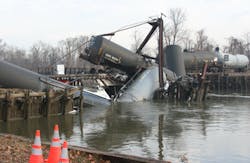NOAA partners with Dow to update chemical safety software tool
The National Oceanic and Atmospheric Administration (NOAA) is partnering with Dow Chemical to release an update to a federal software program used to prevent chemical incidents and help protect emergency workers responding to hazardous chemical spills, according to NOAA's Response and Restoration Blog.
This newest version of the program, known as the Chemical Reactivity Worksheet, is the result of a two-year-long collaboration between NOAA chemical response specialists, technical experts from Dow and other companies and the Center for Chemical Process Safety.
The free software predicts potential hazards from mixing chemicals and is designed for use by emergency responders and planners, as well as the chemical industry.
RELATED: Latest rules for monitoring unregulated contaminants now in force
“This is an innovative collaboration between industry and government scientists to produce a valuable tool that addresses reactive chemical hazards,” said Jim Farr, NOAA chemist and project coordinator. “We hope this effort paves the way for other projects that enhance our understanding of chemical hazards and leads to a safer work environment for those people in the chemical industry and those that respond to chemical incidents.”
“We’ve greatly appreciated the opportunity to partner with NOAA on this and see this as a win-win for everyone,” said Dave Gorman, Dow chemist and project leader. “This collaboration has allowed us to merge a number of best practices and tools used within Dow with the very powerful Chemical Reactivity Worksheet tool. The result is a much more powerful and versatile tool that we hope will become the gold standard within industry for determining chemical compatibility.”
This latest release of the software increases the number of reactive groups in the program, allowing for more refined predictions of potential chemical reactions. In addition, managers of chemical facilities and university chemistry departments now can add to the program those chemicals unique to their facilities, enabling them to further customize their evaluations of potential hazards. The update expands the description of each reactive chemical and now includes both an alert for possible gases released from a chemical mixture and a reference on the compatibility of common absorbents used in response to spills of hazardous chemicals, according to Dow.
The Chemical Reactivity Worksheet is available for free download online at http://response.restoration.noaa.gov/reactivityworksheet.
